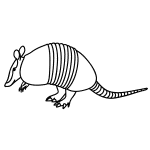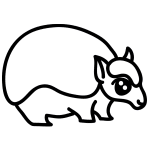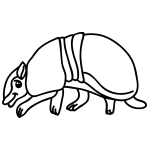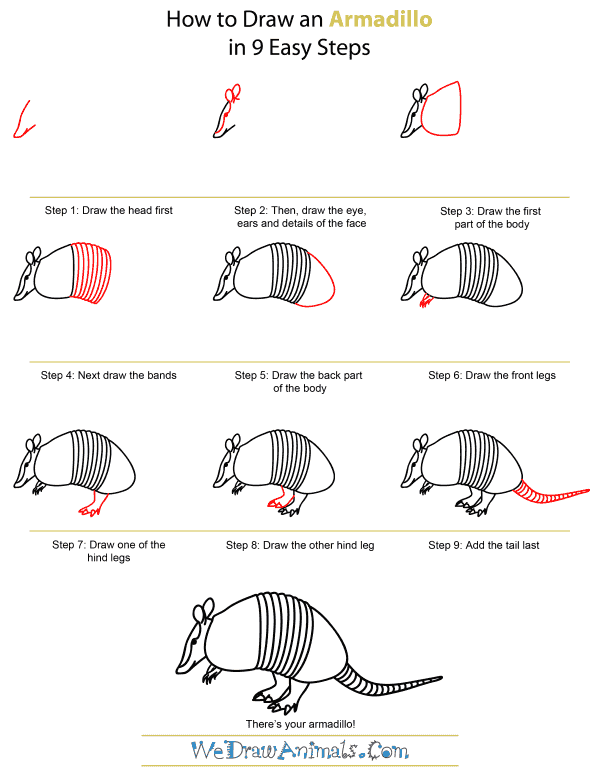In this quick tutorial you'll learn how to draw an Armadillo in 9 easy steps - great for kids and novice artists.
The images above represent how your finished drawing is going to look and the steps involved.
Below are the individual steps - you can click on each one for a High Resolution printable PDF version.
At the bottom you can read some interesting facts about the Armadillo.
Make sure you also check out any of the hundreds of drawing tutorials grouped by category.
How to Draw an Armadillo - Step-by-Step Tutorial
Step 1: First we need to draw the Armadillo's head! Start with a slanted line, that barely curve to make the eyebrow. Then, continue the line down to make the snout. Curve the line up to draw the nose, and then up some more to make the chin. Add another small line halfway down the chin to make the mouth.
Step 2: Now you add in the Armadillo's face plate, eyes, and ears! The face plate looks tricky, but its easy. Just do two curved lines, starting at the top of its forehead, traveling down to just above the eyebrow you drew earlier. Then another curved line should go down and connect near to its nose. Put a small circle between these lines to make an eye, and two small ovals at the very top to make the ears.
Step 3: Now draw a big backward D to make the shoulders and front part of the Armadillo's body. The curved part of your D should connect the top and bottom of the Armadillo's head.
Step 4: Next we can put in the armored bands that help the Armadillo be protected while turning left and right! It looks like a lot, but its easy! Just draw 8 lines right next to the big backward D that you have already drawn. Then, connect the lines at the top and bottom with slightly bumpy lines.
Step 5: Draw the rear of the Armadillo. Simply make a big curve that starts at the last armored band you drew on its back, and curves down and around to connect to the armored bands on its belly.
Step 6: Now draw little hands, so the Armadillo can pick things up and dig. The tiny hands have small claws on them too, so don't leave those out!
Step 7: Drawing the feet is easy. Just make a sock shape that extends down, just behind the bands you drew earlier. The end of the sock should have a few claws on it too.
Step 8: The next foot should be the same, but drawn just a bit in front of the leg you've already drawn.
Step 9: Lastly you draw the tail! Just two curved lines that stretch back from his rear, and meet at a point. The Armadillo has stripes on its tail, so just add some lines to make those.
Interesting Facts about Armadillos
Armadillos are known for their armor-like backs. The word armadillo is Spanish for “little armored one.” Their shell covers their back, legs, tail, and head. Their snouts are either pointy or shaped like a shovel.
Did You Know?
- There are 20 species of armadillos.
- The giant armadillo is the largest of all. It is five feet long and weighs about 132 pounds.
- Armadillos are the only living animals that have shells.
- Only one species of armadillo, the three-banded armadillo, can hide inside its shell like a turtle. It is also the only species found in the United States.
- Armadillos are closely related to anteaters and sloths.
- An armadillo’s typical diet includes insects, plants, vertebrates, and some fruit.
- The armadillo’s strong sense of smell makes up for its poor eyesight.
- Armadillos sleep up to 16 hours per day, and they are mostly active at night.
- In different cultures throughout the Americas, people eat armadillo meat, which is said to taste like pork.
Armadillos live in temperate and warm climates throughout Latin America. They can be found in grasslands, semi-deserts, and rainforests. Some species of armadillos are at risk of becoming endangered. The nine-banded armadillo’s population is the only one that is growing.













